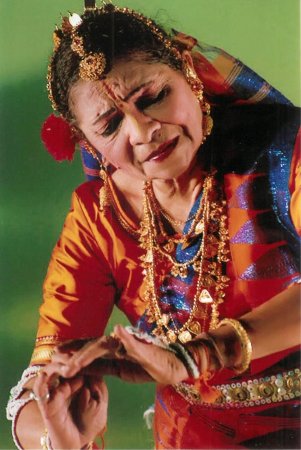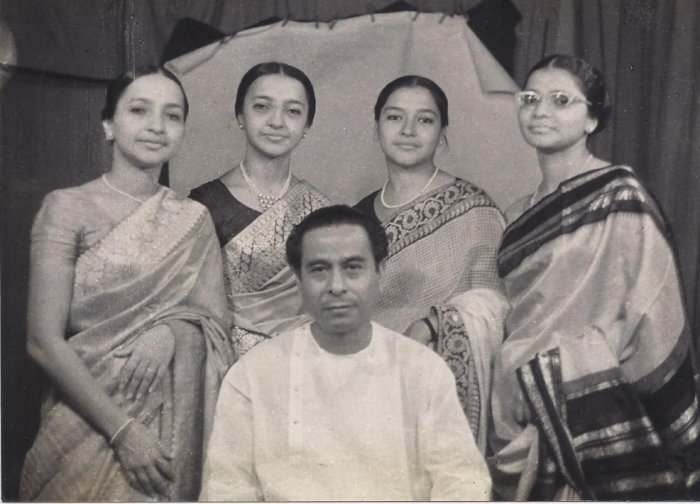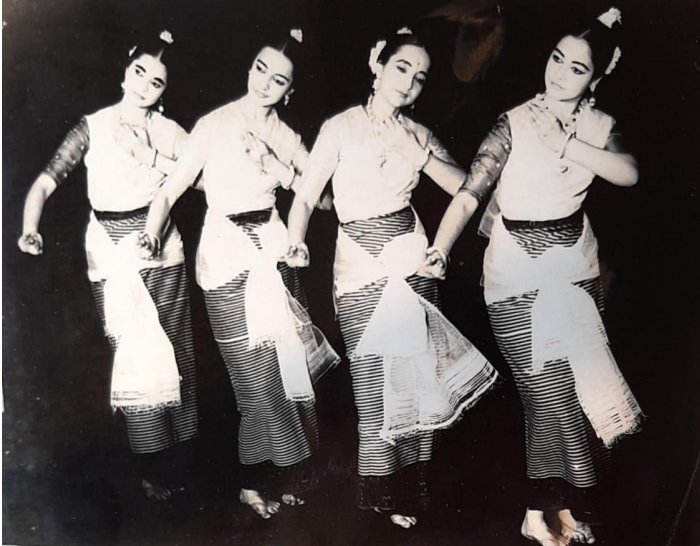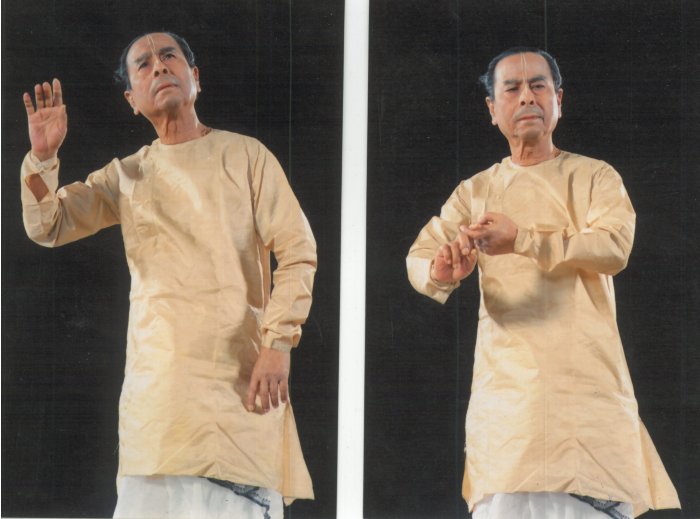
|
 |

|
 |
Darshana Jhaveri: Recording oral traditions for posterity - Tapati Chowdhurie e-mail: tapatichow@yahoo.co.in Photos courtesy: Darshana Jhaveri April 22, 2025  Darshana Jhaveri Darshana Jhaveri is a distinguished name in the field of Manipuri dance of Guru Bipin Singh style. I had the rare chance of meeting the octogenarian performer at the 51st Khajuraho Festival of dance. Chances like this are rare and I seized this opportunity to interview her. The following are some of her brilliant answers to my questions. What inspired you to learn Manipuri dance? The 40s were the times when the youth in Bombay (Bombay was renamed Mumbai on 6th March 1996) were inspired by Mahatma Gandhi and Gurudev Tagore. Inspired to revive our ancient culture, we started learning classical and folk dances for stage performances.  The Jhaveri sisters with Guru Bipin Singh My eldest sister Nayana learnt little Kandyan dance and Kathakali. I am the youngest and learnt a bit of Kathak from Madam Menaka in New Era School. Then in 1943 my two elder sisters Nayana and Ranjana met Guru Bipin Singh who was directing the Manipuri portion of the dance drama 'Chauladevi'. They immediately took to Manipuri like fish takes to water. Thereafter in other dance dramas like Meerabai, Amrapali, Narsaiyo, where Guru Bipin Singh directed the Manipuri portions, my sisters took part in them. Soon after, Guruji started coming to our house to teach them. Suverna and I followed suit. We thought Guru Bipin Singh was the right Guru for us as his way of teaching Manipuri, his scientific attitude, his creative talent, his aesthetic sensibility, and knowledge attracted us to him. Also, he thought that we four rightly understood the delicate and lyrical style of Manipuri dance. Its devotional nature suited our body, psyche, nature, aptitude and we had that grace required for Manipuri dance. We started taking more interest in learning from Guruji and he was also totally committed and took great interest in training us. Can you touch upon a few facts about your Guru and what attracted students to his art? The way he used to talk and narrate stories attracted students. Also, his grace and style of dancing were very captivating. Whatever he did was so beautiful. His nature was to encourage students to dance and practice more. Students respected him, loved him and always were ready to serve him. Each of us tried to become his favourite. There really was a sort of competition to please him with more practice. In what way was Guru Bipin Singh helped by the Jhaveri sisters to establish himself as a guru?  The Jhaveri sisters In the early 50s, the Jhaveri Sisters produced the dance drama 'Usha' which Guruji directed purely in Manipuri dance style in Bombay; in 1954 another dance drama 'Raj Nartaki' was produced and Guruji directed it by using different forms of Manipuri like Pung Cholom, Kartal Cholom, Thang-Ta (Sword & Spear) dance and invited Manipuri male dancers from Cachar in Tripura. During that time, he was earning a lot by giving dance tuition in students' houses, but gradually the Jhaveri Sisters told him to leave everything and devote all his time and energy in researching on Rasleela and Sankirtan - the two classical forms of Manipur - and studying the ancient Vaishnavite Sangeet Shastras; collecting and recording of oral tradition of Ras and Sankirtan; co-relating them with Vaishnava Shastras and composing new pieces for stage with its root in tradition and devise courses for students. For all these activities, the Jhaveri sisters collaborated with financial support from our parents. I was a full-time assistant in all his activities. It was practically a Gurukula system of learning. Guruji came to our house sharp at 7am to study the shastras, in which we were participants. Then we had dance classes followed by music classes till six in the evening. How would you explain the 'abhinaya' part of Manipuri? In Manipur, ancient traditional dance of Lai Haraoba which goes back to 2000 years, is Maibi Jagoi (Dance of the priestesses), who describe primitive concept of cosmology through 364 hand gestures while worshiping village Gods. They describe creation of earth, creation of the human body and activities like weaving cloth, building houses, fishing, agriculture etc. These can be called the origin of hand gestures. With the advent of Vaishnavism in the 18th century, the dance style became more stylized and was codified in Rasleela (dance dramas) having stories of Krishna and Radha. The uses of hand gestures are suggestive, facial expressions are natural, subdued, restrained, and body movements are used to convey meaning of the songs. As far as the tala system of Manipuri dance is concerned, what are the prevalent talas used? Manipuri gurus have developed individual Tala systems. Talas range from 4 beats to 68 beats divided into shuddha, shalag, sankirna - the prevalent Talas are Tanchep (4 beats), Menkup (6 beats), Tevda (7 beats), Chali (8 beats), Chowtal (12 beats), Chartal (14 beats), Brahmatal (28 beats), etc. It was 7 variety of 7 beats Talas like Dashkash, Tintal Macha, Dutala Tintal, Rajmel, Triputaswari, Jatra Rupak - each having different Angas i.e. divisions with rhythm patterns on them having different effect. The rhythm pattern of one Tala cannot be used for another tala. What are the talas introduced by Guru Bipin Singh?  Guru Bipin Singh Guru Bipin Singh had mastery over Talas and Tala systems. He revived some talas like Veeradhashaka (24 beats), Sapta Tala (20 beats), Khuji Tala (16 beats), Laxmitala (36 beats), Kankan (11 beats), Gajendraguru (24 beats), Tal Makaranda (8 beats). What did Guru Bipin Singh choreograph and compose exclusively for you and your sisters? Guru Bipin Singh composed for us items like Khandita, Utkanthita, Nannichuri, Pontha Jagoi, Kankan, Sakshatdarshan, Angangakshep, Swara Prabandha, Vasantras (dance drama), Gopigoshtha (dance drama), Kaitav Milan (dance drama), Manbhanjan, Manini Radha, Abhisarika, Purvarag (dance drama), Bajikarvesh (dance drama), Kandhukkhel. Why are ankle bells not worn by Manipuri dancers? The costume makers say that previously bells were worn but then they turned them into bead ornaments called Nupoor worn on the ankles as well as V shaped bead ornament on the upper part of the feet. Is sitting on your knees and going round the stage a new addition in Manipuri dance or was it always there? Baglaiba or turning round on knees is traditionally done with Pung by male dancers in Sankirtan and also by Krishna in Rasleelas. What is the importance of Pung in Manipuri dance? Pung is a special kind of drum used in Manipuri dance. Guruji was the first person to strongly believe that a student who is learning to dance must know beat of bols in his/her pung (Mridang-drum). He/she needs to play the pung so that he/she can understand the Chhanda of the bols played for dance and follow that rhythm while dancing. I started learning to play the drum in Bombay from our drummer Birmangal Singh and Guru Meitei Tomba who was teaching me sequence of Natpala (Sankirtan). Since then, I am learning, practicing, playing and teaching also. In Manipur, I had also learnt Pung Cholom (dance with pung) during 60's from Guru Natek, Guru Amuyaima Singh. It is very interesting but hard for women to dance and play as it requires a lot of energy. Since you seem to have learnt in the Guru-Shishya Parampara and are passing down Manipuri dance to the generation next , what has been your experience? How we learned from Guru Bipin Singh, in the then Bombay, was altogether a different experience. We learnt traditional Bhangi Parengs in the 50s from Guruji by imitating him; then we learnt dance movements, followed by bols, talas and songs. But after Guruji formulated a training course, we started teaching children the basic movements of each part of the body taken from the traditional dances of Rasleela like feet movements, arms, hand, fingers, jumping, sitting, turning round in lasya and tandava, so that children know the basic characteristics of the Manipuri dance style and after knowing that, they grasp easily the full dance composition. So, for me, this way of teaching in the cities to the school children became very easy and bore quick results. Similarly, teaching talas and writing bols and songs became easy. What has been your contribution to Manipuri dance?  Darshana Jhaveri With more and more experience in dancing, my understanding of the style, movements, the rhythm of the bols, its relation with the movements improved and got polished more and more. Intense practice perfected the form. Teaching gives me immense joy, emphasizing the style in all its minute details like, where to stretch, where to bend on your knees - which are of great beauty in Manipuri dance, specially in the rendition of lasya parts, where to bend and then jump in tandava. It is pleasurable to teach meticulously the controlled and restrained movements that are the hallmark of Manipuri dance form. I know all the dances of the 8 years course and all the compositions done by Guru Bipin Singh, as I was continuously with him in all his varied activities, which has made me aware of beauty and the nuances of each and every dance piece, which I am able to teach aspiring dancers and students. This in turn is helping them to teach their students. I was with Guruji while recording the 150 hours of oral traditions right from the start till they were transferred from cassette to YouTube and then putting them in digital form for posterity. Similarly, I have transferred the full 8 hours course study of the syllabus conceived by Guruji from DVDs to YouTube and have installed all compositions of Guruji to YouTube in 21 episodes for the benefit of generations to come. I am associated with four Universities and am on their committees of Board of studies, where my course is being taught. I am an examiner specializing in both theory and practical, online and offline. How did Manipuri dance emerge fit for the proscenium stage? Manipuri dance was developed for the proscenium stage by Guru Bipin Singh. He composed items in collaboration with all four of us and Kalavati Devi, which we presented on the proscenium stage in a very sophisticated way. The choreography, marvellous arrangement of the items suited to audience appreciation gave Manipuri dance a permanent place on the proscenium stage. The beauty of Guruji's compositions made it possible for us to dance with other dance styles on the same platform in conferences and festivals. We were appreciated and got many invitations to dance tours in India and abroad from 1958. Can you share your own personal observations? Times are changing. The youth of today are people whose aesthetic standards are high. They look for technical mastery and good abhinaya that will create aesthetic joy. Rasanubhuti of the Sahriday is the ultimate goal of the performer.  Tapati Chowdhurie trained under Guru Gopinath in Madras and was briefly with International Centre for Kathakali in New Delhi. Presently, she is a freelance writer on the performing arts. She is the author of 'Guru Gopinath: The Making of a Legend.' Post your comments Please provide your name and email id when you use the Anonymous / blog profiles to post a comment. All appropriate comments posted with name and email id in the blog will be featured in the site. |